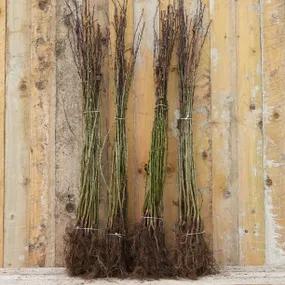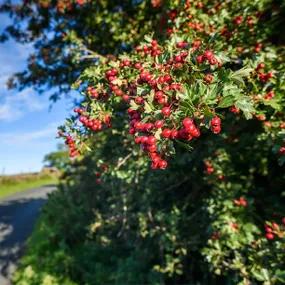Pre-Order Bareroot Hawthorn For 2025/26 Winter Season
What is Hawthorn Hedging?
Hawthorn, Crataegus monogyna, also known as Quickthorn or Whitethorn, is the most widely used hedge plant in the UK, equally at home as a stock proof farm hedge or in the inner city.
It is the backbone of mixed country hedging and conservation hedging; our Countryside Stewardship Grant Essential mix is half Hawthorn, half Blackthorn.
Hawthorn has all the virtues you look for in secure hedging: moderate growth rate, incredibly tough, happy in almost any soil, easy to clip, and so dense that even in winter when it is leafless, a well-grown hawthorn hedge is almost impossible to see through.
It produces masses of simple, white blossom in mid-spring. The glossy green foliage looks good all summer, and in autumn it's decked with bunches of bright red haws.
- Uses: Country and stockproof hedges from 100cm upwards
- Good Points: Native, cheap, bomb-proof, almost year-round interest
- Position: Almost anywhere
- Growth: 40-50cm per year
You can also buy larger ornamental Hawthorn trees.
How many Hawthorn hedge plants do I need?
The planting density for your Hawthorn hedge depends on the purpose:
- For a normal garden boundary hedge, plant at 3 plants per metre (every 33cm) in a single row.
- A stock-proof country hedge requires 2 staggered single rows (i.e. start one row 16.5cm after the other), with 40cm between rows. That works out at 6 plants per metre in total.
What size Hawthorn hedge plants should I buy?
- If you are not in a hurry to get a full sized Hawthorn hedge, we recommend starting with the smallest sizes, either 40/60cm or 60/80 tall.
- If you are in a hurry and need instant impact, or are filling gaps in an existing hedge, then of course pick the biggest size that fits your budget.
Smaller plants are cheaper, easier to plant, and tend to establish better because they are dug up with most of their roots intact.
You can also clip them attentively and ensure a very bushy plant from the base up.
Buying Hawthorn Hedging
Your mail order hawthorn hedge plants are delivered by next working day courier.
If there is anything wrong with your plants when they arrive, Contact Us within 5 working days, and our friendly support team will sort it out.
All bareroot plants are covered by our Refund Guarantee, so you can give them a whirl with complete confidence.
Browse our range of hedging plants, many of which can be interplanted with Hawthorn for more variety: have a look at our mixed hedge packs for inspiration.
Hawthorn is the common name for members of the Crataegus genus in the Rosaceae plant family: relatives of roses, and most European fruit trees.
In the wild, they are small to medium-sized trees, and with clipping they make perfect hedge plants.
Why are Bareroot Plants so Good?
The majority of hedging plants and trees in the UK are planted bareroot, but for many new gardeners, the idea of buying a plant with no soil around its roots feels wrong: how can they survive transit without a pot?
The secret is that they are sleeping (dormant) in winter, and during their brief time out of the field we store them in chilled, humid conditions that keep them nice and moist.
Then we wrap them up well and send them to you by next day delivery.
We only sell Hawthorn hedging as bareroot plants.
Hawthorn Versus Blackthorn, What's the Difference?
Hawthorn and blackthorn are the two most popular native country hedge plants in the UK
- Mixed together, they make a great animal barrier & windbreak
- Both are very tough and grow almost anywhere
- In shady locations, Hawthorn is better
- In sunny exposed location, dry coastal sites, Blackthorn is better
How long does a Hawthorn hedge take to grow?
Hawthorn plants are moderately vigorous, growing up to 50cm per year, depending on your location (plants generally grow faster in the warmer South & West than in the cooler East & North of Great Britain) and your local conditions (wind-shelter and full sun are ideal).
However, as with any hedge, you must trim it to get lots of dense, bushy growth down to the base. So, there is a balance to be struck: aim for about 20cm of growth after trimming in the first few years.
Bear in mind that it is common for most plants to put on very little height in their first year after being transplanted into your garden.
There is nothing wrong with this: they are laying down roots first, in readiness for growing upwards and filling out.
How big does a Hawthorn hedge grow?
From about 1 metre up to about 4-5 metres.
How do I plant a Hawthorn Hedge?
Planting Hawthorn
Our film on How to Plant a Country Hedge was made with mixed hedging in mind, but it applies equally to a solid Hawthorn hedge.
Hawthorn is truly tough, however, a little preparation (and protection from rabbits if necessary) will help ensure your plants establish as quickly as possible. We always recommend Rootgrow when planting, especially in poorer soils: it makes a big difference! And it is important to keep weeds under control for the first 2- 3 years. Either spray them off before planting and again when there is no leaf on the hedge, or suppress them using organic mulches or Mypex.
If you want a stock proof hedge, plant in a staggered double row at six plants per metre. If your hawthorn hedge is just for screening, then plant in a single row at three plants per metre. It will no longer stop a charging bull, but it will still be dense enough to keep out trespassers and prying eyes.
How and When do I Prune & Trim Hawthorn Hedging?
Pruning Hawthorn Hedging
Pruning work is required right after planting in order for your new hedge to become as bushy as possible from the ground. The first two "prunings" are easy, but important. Get them right and it will become impenetrable!
Cut Hawthorn Hedge plants back after Planting
On the day you plant them, cut your hedging back by HALF. As in 50%. Many people cut them back a bit more, down to 6" (15 cms), with great success. This is a bit like pruning a rose; dormant buds below the cut put out new growth in spring. Each little "stump" can produce as many as 5 (but more usually 3 or 4) new branches as a result.
And cut Hawthorn Hedges back again a year later
Assuming you planted between October and April, make the second cut the following winter, roughly a year later when the leaves have fallen. With secateurs or hedge trimmer, carefully cut all the NEW growth (i.e. growth that is no more than a year old) back by HALF. Yes, that really is 50% and it really applies to ALL the new growth made since the first cut. This will have the effect of causing each newly pruned branch to put out 3-5 new growths the following March.
Hawthorn - Trimming in later years
As a result of the first two cuts, your plants are now sturdy, rounded bushes with between 9 and 15 branches each. Over the following years, these will lengthen and thicken and you will not have to make savage cuts like the first two again.
You can trim your mature hawthorn hedge at any time of year, but the best time is when they look ragged in autumn.
Try to clip your hedge to a tapered shape - all hedges whether native or formal should be wider at the bottom than at the top to let light get to the lower branches and keep them leafy.
For the best display of flowers and haws, the trick is to leave a few inches of the previous year's growth.
Kept clipped, your hedge should give you decades of service. However, if it is neglected, after 10-15 years, gaps can appear at the base. These can be dealt with by "laying" which will make your hedge as good as, or sometimes even better than, new.
Are hawthorn berries edible?
Hawthorn's red fruit, called haws, are not strictly berries. They are similar to rose-hips: the flesh is dry, mealy, quite nutritious, and should be separated from the seeds before consumption.
- This is a laborious process; almost no one use them as food, only for herbal remedies.
- The best time to pick them is after the first frosts, which softens them, making it easier to squeeze the flesh off the seeds.
- Try eating the fresh green shoots in Spring, lightly steamed or boiled, these used to be a common vegetable.
In our opinion, leave the Haws for the birds, grow proper fruit instead; blackberries do well mixed into country hedges.





